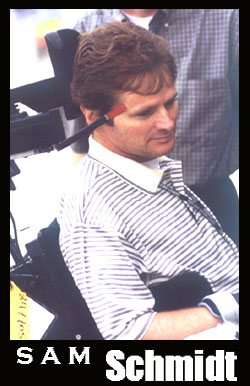Northern Light IRL: Mari Hulman George Donates $2.7 Million for Spinal Cord Research
22 November 2000
Posted By Terry
Callahan
Motorsports Editor, The Auto Channel
INDIANAPOLIS - Indianapolis Motor Speedway Chairman
Mari Hulman George is contributing $2.7 million to Purdue University and
Indiana University to establish endowed professorships at both schools for
their joint paralysis research efforts.The gift will be used to create a named professorship in the Purdue School of Veterinary Medicines Institute for Applied Neurology and a named chair in the IU School of Medicines Division of Neurosurgery.
"I am pleased to be able to help both Indiana and Purdue universities in their research to help victims of spinal cord injuries," George said. "In this season of Thanksgiving, perhaps this gift will help give more hope to those victims and their families who are looking forward to new developments.

|
"Here with us today is Nicole Richards, hurt in an auto accident. Sam Schmidt, a star of the Indy Racing League, was hurt in a racing accident. And my grandson Jared suffered severe injuries in a BMX racing bike accident when he was 9 years old. Thankfully, he has fully recovered.
"In recent years much progress has been made, and we will hear today of more progress. Like all medical progress, adequate funding is needed for basic research. We are fortunate to have in our state two distinguished institutions where research is yielding results and renewed hope for victims of spinal cord injuries."
Georges gift will augment funding from the state of Indiana, which committed $1 million annually for two years to Indiana and Purdue universities to support the application of research on spinal cord and head injuries.
The first human clinical trial of a new treatment for spinal cord injuries was announced Nov. 20 by the Purdue School of Veterinary Medicine and the Indiana University School of Medicine at the Indianapolis Motor Speedway. The FDA-approved trial at IU is based on treatments developed at Purdue. In these treatments, dogs suffering paralysis from natural causes regained partial function.
The human clinical trial will test whether weak electrical fields applied to spinal cord injuries can promote better functional recovery through regeneration of injured spinal cord nerve fibers. The electrical fields are imposed over the spinal cord injury through use of a new implantable medical device, called an extraspinal oscillating field stimulator.
The trial will begin later this year and is open to patients between the ages of 18 and 65 who have suffered a spinal cord injury. Patients must be entered into the trial within 18 days from the time of their injury; there are other exclusionary criteria that are available from the clinical trials coordinator.
"Our family has been touched by this, as have many," George said. "I very much appreciate what the state of Indiana is doing to help, and especially the efforts of Dr. Borgens and Dr. Nelson.
"It is my dearest wish that these gifts will inspire others to help also, and that the state of Indiana will see fit to continue its funding of this wonderful research. And I hope that the result of the research will improve the lives of those we love so much, be they animal or human."
Purdue Professor Richard Borgens, director of the Institute for Applied Neurology, said the state support coupled with Georges contribution is helping speed the process of bringing promising experimental treatments into actual human clinical trials.
"In the past, we have had to apply for grants and corporate sponsorships in order to fund human trials, and that process can take many years," he said. "Now we have been able and will continue, to move more quickly into human trials with techniques found to be both safe and effective on animal patients."
Dr. Paul Nelson, Betsey Barton Professor and chairman of the neurosurgery division at IU, said the pairing of the two universities is unique.
"This is the beginning of our research into treatments that can be used collectively to improve the regeneration of the injured human spinal cord," Nelson said. "The IU-Purdue collaboration in spinal cord research is an important partnership. It fits the universities drive to engage in translational research, which creates an effective bridge between basic science research and patient care."
Spinal cord injuries represent a growing medical and financial dilemma for state governments, yet only a few other states -- Kentucky, Florida and Virginia among them -- fund paralysis research.
The Indiana General Assembly approved the effort in spring 1999 and made the money available in July 1999. The funds provide a stable operating budget for equipment and professional staff who will conduct coordinated research and test new developments.
Text Provided By Paul Kelly
Editors Note: To view hundreds of hot racing photos
and art, visit
The Racing
Photo Museum and the
Visions
of Speed Art Gallery.


